项目管理
- 格式:doc
- 大小:41.50 KB
- 文档页数:6
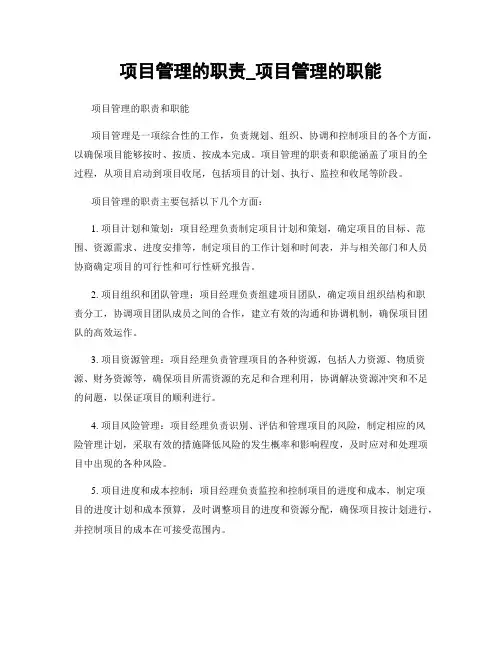
项目管理的职责_项目管理的职能项目管理的职责和职能项目管理是一项综合性的工作,负责规划、组织、协调和控制项目的各个方面,以确保项目能够按时、按质、按成本完成。
项目管理的职责和职能涵盖了项目的全过程,从项目启动到项目收尾,包括项目的计划、执行、监控和收尾等阶段。
项目管理的职责主要包括以下几个方面:1. 项目计划和策划:项目经理负责制定项目计划和策划,确定项目的目标、范围、资源需求、进度安排等,制定项目的工作计划和时间表,并与相关部门和人员协商确定项目的可行性和可行性研究报告。
2. 项目组织和团队管理:项目经理负责组建项目团队,确定项目组织结构和职责分工,协调项目团队成员之间的合作,建立有效的沟通和协调机制,确保项目团队的高效运作。
3. 项目资源管理:项目经理负责管理项目的各种资源,包括人力资源、物质资源、财务资源等,确保项目所需资源的充足和合理利用,协调解决资源冲突和不足的问题,以保证项目的顺利进行。
4. 项目风险管理:项目经理负责识别、评估和管理项目的风险,制定相应的风险管理计划,采取有效的措施降低风险的发生概率和影响程度,及时应对和处理项目中出现的各种风险。
5. 项目进度和成本控制:项目经理负责监控和控制项目的进度和成本,制定项目的进度计划和成本预算,及时调整项目的进度和资源分配,确保项目按计划进行,并控制项目的成本在可接受范围内。
6. 项目质量管理:项目经理负责制定项目的质量管理计划,确保项目的交付物符合质量要求,制定质量控制措施和检查方法,监督和检查项目的质量执行情况,及时纠正和改进项目中存在的质量问题。
7. 项目沟通和协调:项目经理负责与项目相关方进行沟通和协调,包括项目发起人、项目团队成员、项目合作伙伴、项目利益相关方等,及时传递项目信息,解决问题和冲突,确保项目各方的利益得到充分考虑和满足。
8. 项目评估和总结:项目经理负责对项目进行评估和总结,总结项目的经验教训和成功经验,提出改进措施和建议,为今后的项目管理工作提供参考和借鉴。

什么是项目管理项目管理是指对项目进行规划、组织、协调和控制,以实现项目目标的过程。
它是一种在特定时间范围内,通过有效管理资源和风险来完成项目的方法。
在现代社会中,项目管理已经成为各个行业的重要工具,广泛应用于建筑、信息技术、制造业、金融等领域。
项目管理的核心目标是确保项目在预定时间内、在限定的资源和预算条件下,按照事先确定的质量标准和预期的目标完成。
项目管理强调团队协作、风险管理、沟通和有效利用资源,以实现项目的成功。
项目管理主要由以下几个方面组成:1. 项目计划:在项目开始之前,项目经理需要对项目进行详细的规划。
这包括确定项目目标、制定项目计划、确定项目所需资源和时间表。
项目计划的制定需要充分考虑项目的可行性、风险以及各种变数。
2. 项目组织:项目组织是指确定项目团队的成员和其职责。
项目经理需要根据项目的需求和要求,招募合适的人员组成项目团队。
同时,项目经理还需要明确每个成员的责任和权力,确保项目团队的协作和高效运作。
3. 项目执行:在项目开始之后,项目经理需要根据项目计划,对项目进行实施和监督。
项目经理需要确保项目按照预期的目标和计划进行,同时及时处理项目中遇到的问题和挑战,以便项目能够顺利进行。
4. 项目控制:项目控制是指对项目的进展进行监控和控制,以确保项目在时间、成本、质量和风险等方面能够达到预期目标。
项目经理需要对项目的进展进行定期评估,并根据评估结果调整项目计划和资源分配。
5. 项目结束:在项目完成之后,项目经理需要对项目进行总结和评估。
这包括对项目的成果进行验收、对项目的经验进行总结和归档。
同时,项目经理还需要与相关利益方进行沟通,汇报项目结果和效果。
项目管理的重要性在于它可以帮助组织有效管理项目,避免项目因时间、成本等方面的问题而失败。
良好的项目管理可以提高组织的竞争力,改善工作效率,减少资源浪费。
项目管理还可以提早发现和解决项目中的问题,降低项目失败的风险。
然而,要实现良好的项目管理,并非易事。
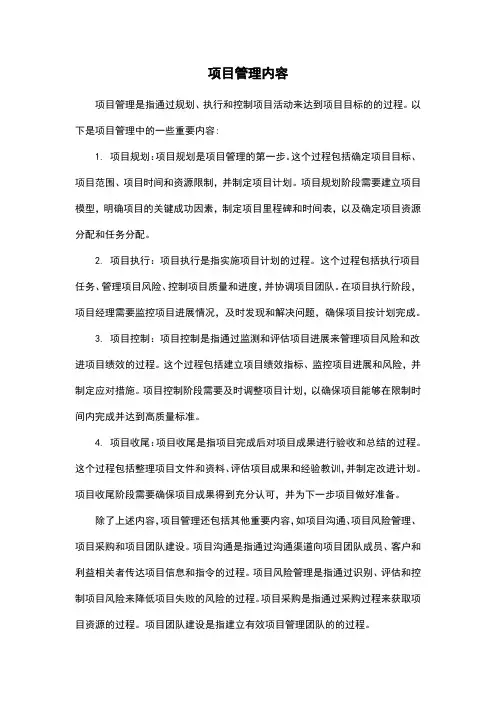
项目管理内容项目管理是指通过规划、执行和控制项目活动来达到项目目标的的过程。
以下是项目管理中的一些重要内容:1. 项目规划:项目规划是项目管理的第一步。
这个过程包括确定项目目标、项目范围、项目时间和资源限制,并制定项目计划。
项目规划阶段需要建立项目模型,明确项目的关键成功因素,制定项目里程碑和时间表,以及确定项目资源分配和任务分配。
2. 项目执行:项目执行是指实施项目计划的过程。
这个过程包括执行项目任务、管理项目风险、控制项目质量和进度,并协调项目团队。
在项目执行阶段,项目经理需要监控项目进展情况,及时发现和解决问题,确保项目按计划完成。
3. 项目控制:项目控制是指通过监测和评估项目进展来管理项目风险和改进项目绩效的过程。
这个过程包括建立项目绩效指标、监控项目进展和风险,并制定应对措施。
项目控制阶段需要及时调整项目计划,以确保项目能够在限制时间内完成并达到高质量标准。
4. 项目收尾:项目收尾是指项目完成后对项目成果进行验收和总结的过程。
这个过程包括整理项目文件和资料、评估项目成果和经验教训,并制定改进计划。
项目收尾阶段需要确保项目成果得到充分认可,并为下一步项目做好准备。
除了上述内容,项目管理还包括其他重要内容,如项目沟通、项目风险管理、项目采购和项目团队建设。
项目沟通是指通过沟通渠道向项目团队成员、客户和利益相关者传达项目信息和指令的过程。
项目风险管理是指通过识别、评估和控制项目风险来降低项目失败的风险的过程。
项目采购是指通过采购过程来获取项目资源的过程。
项目团队建设是指建立有效项目管理团队的的过程。
总结起来,项目管理是一个重要的过程,可以帮助企业或个人有效地组织和管理项目,确保项目能够在限制时间内完成并达到高质量标准。

项目管理常识一、项目管理的定义项目管理是指通过科学的方法,对项目的目标、范围、进度、成本、质量、风险等进行规划、组织、指导、控制和协调的过程。
其目的是确保项目在预定的时间、成本和质量要求下顺利完成,并达到项目的目标。
二、项目管理的重要性1. 提高项目的成功率:项目管理可以帮助项目团队明确项目目标和需求,并制定合理的计划和策略,从而提高项目的成功概率。
2. 提高项目的效率和质量:项目管理可以帮助团队合理安排资源、优化进度,提高工作效率,同时关注质量管理,确保项目交付的产品或服务符合质量要求。
3. 降低项目的风险:项目管理通过风险管理和问题解决,帮助团队预测和应对项目中可能出现的风险和问题,降低项目失败的风险。
4. 提高团队协作和沟通:项目管理强调团队合作和沟通,通过明确的角色和责任分工,建立高效的沟通机制,促进团队成员之间的协作和有效沟通。
5. 提高客户满意度:项目管理注重客户需求管理和变更控制,确保项目交付的成果符合客户期望,提高客户满意度。
三、项目管理的主要过程1. 项目启动:明确项目目标、范围、约束条件等,制定项目章程和项目管理计划。
2. 项目规划:制定详细的项目计划,包括工作分解结构(WBS)、进度计划、资源计划、质量计划、风险管理计划等。
3. 项目执行:按照项目计划,组织、指导和控制团队成员进行工作,同时进行沟通、风险管理和问题解决。
4. 项目监控:对项目的进度、成本、质量、风险等进行监控和控制,及时发现并解决问题,确保项目按计划进行。
5. 项目收尾:对项目交付的成果进行验收,总结项目经验教训,进行项目收尾报告,确保项目的顺利结束。
四、项目管理的关键要素1. 项目目标:明确项目的目标和交付成果,确保整个项目团队朝着相同的目标努力。
2. 项目范围:明确项目的范围,界定项目的边界和可交付成果,避免范围蔓延和需求变更。
3. 项目计划:制定详细的项目计划,包括工作分解结构、进度计划、资源计划、质量计划、风险管理计划等。
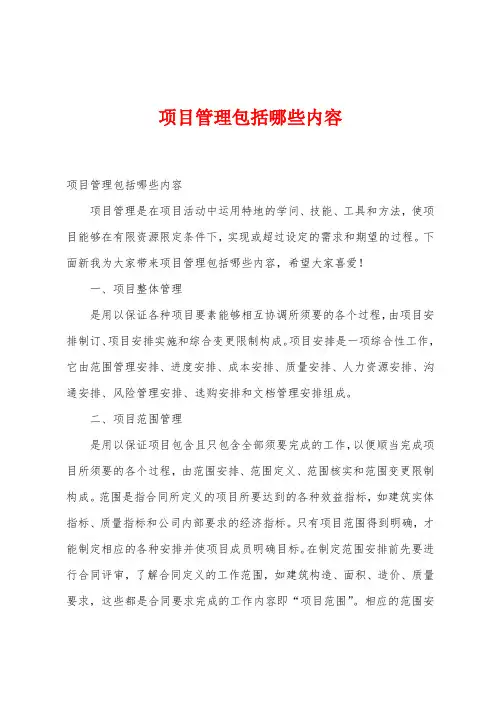
项目管理包括哪些内容项目管理包括哪些内容项目管理是在项目活动中运用特地的学问、技能、工具和方法,使项目能够在有限资源限定条件下,实现或超过设定的需求和期望的过程。
下面新我为大家带来项目管理包括哪些内容,希望大家喜爱!一、项目整体管理是用以保证各种项目要素能够相互协调所须要的各个过程,由项目安排制订、项目安排实施和综合变更限制构成。
项目安排是一项综合性工作,它由范围管理安排、进度安排、成本安排、质量安排、人力资源安排、沟通安排、风险管理安排、选购安排和文档管理安排组成。
二、项目范围管理是用以保证项目包含且只包含全部须要完成的工作,以便顺当完成项目所须要的各个过程,由范围安排、范围定义、范围核实和范围变更限制构成。
范围是指合同所定义的项目所要达到的各种效益指标,如建筑实体指标、质量指标和公司内部要求的经济指标。
只有项目范围得到明确,才能制定相应的各种安排并使项目成员明确目标。
在制定范围安排前先要进行合同评审,了解合同定义的工作范围,如建筑构造、面积、造价、质量要求,这些都是合同要求完成的工作内容即“项目范围”。
相应的范围安排也就应运而生,如进度安排范围——起先和结束时间。
同时项目范围包括工作分解结构,既将工程实体分解成实际须要分解的各种阶段并进行细化和定义,使整个工程可以通过范围安排清楚地呈现出来。
在项目范围安排中必需包括范围变更限制措施,一个项目从起先到结束多少都会发生一些范围变更,照实现没有对变更有一个应对方案,一旦变更出现就会应接无暇,出现变更得到实施,但由此引起的费用和进度方面的调整无法刚好得到更正确认,导致项目完成后在经济利益和时间利益上受到损失。
三、项目时间管理是用以保证能够按时完成项目所需的各个过程,由活动定义、活动排序、活动历时估算、进度安排编制和进度安排限制构成。
活动定义和排序就是将整个工程分解成能够限制的一些细分的节点,然后依据这些节点的工作内容推算出每个节点的用时从而编制出进度安排。

什么是项目管理?
项目管理(简称PM),是项目的管理者,在有限的资源约束下,运用系统的观点、方法和理论,对项目涉及的全部工作进行有效地管理。
即从项目的投资决策开始到项目结束的全过程进行计划、组织、指挥、协调、控制和评价,以实现项目的目标。
“现代管理,项目就是一切,每个人都是一个项目管理者”。
项目管理是变理想为现实,化抽象为具体的一门科学和艺术。
强调计划性
对项目结果进行规划和估算,制定总体目标和要求
对项目过程进行详细计划、分解,具体分解各任务的活动、时间、资源、成本
预先规划好项目的质量、风险、沟通、外包事宜
强调责任明确、清晰
明确项目、任务、工作的责任人、牵头人、执行人(包括所有项目干系人的责任)
明确与责任人的责任、授权及考核标准
明确考核措施(评审、验证等)
强调过程的控制
不是到最后才看结果,而是项目的全过程都得到适当的指导、监督、纠正,以保证结果
强调控制的持续性、层次性
强调项目信息的沟通和透明
强调项目管理的系统性、全面性和综合性
范围(包括质量要求)、时间、成本三大管理目标的统一
项目管理贯穿全过程,项目启动、计划、执行、控制、收尾
九大管理领域:总体、范围、时间、成本、质量、风险、人力资源、沟通、采购
强调大家都在同一个模式、框架内协同工作
统一的思维框架、议事框架、工作模式
大家都以项目管理的思想考虑如何管理、推进、配合项目的工作并做出行动,有共同的思想基础。
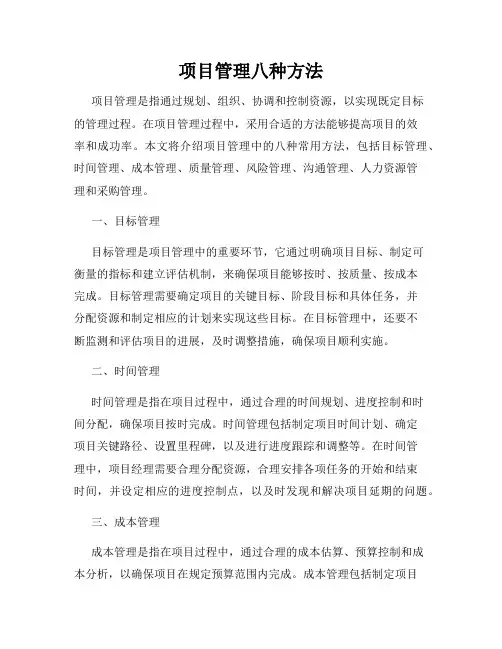
项目管理八种方法项目管理是指通过规划、组织、协调和控制资源,以实现既定目标的管理过程。
在项目管理过程中,采用合适的方法能够提高项目的效率和成功率。
本文将介绍项目管理中的八种常用方法,包括目标管理、时间管理、成本管理、质量管理、风险管理、沟通管理、人力资源管理和采购管理。
一、目标管理目标管理是项目管理中的重要环节,它通过明确项目目标、制定可衡量的指标和建立评估机制,来确保项目能够按时、按质量、按成本完成。
目标管理需要确定项目的关键目标、阶段目标和具体任务,并分配资源和制定相应的计划来实现这些目标。
在目标管理中,还要不断监测和评估项目的进展,及时调整措施,确保项目顺利实施。
二、时间管理时间管理是指在项目过程中,通过合理的时间规划、进度控制和时间分配,确保项目按时完成。
时间管理包括制定项目时间计划、确定项目关键路径、设置里程碑,以及进行进度跟踪和调整等。
在时间管理中,项目经理需要合理分配资源,合理安排各项任务的开始和结束时间,并设定相应的进度控制点,以及时发现和解决项目延期的问题。
三、成本管理成本管理是指在项目过程中,通过合理的成本估算、预算控制和成本分析,以确保项目在规定预算范围内完成。
成本管理包括制定项目成本预算、进行成本控制和成本核算等。
在成本管理中,项目经理需要详细估算项目的成本,并制定成本控制计划,及时追踪和控制项目的成本情况,确保项目没有超支。
四、质量管理质量管理是指在项目过程中,通过制定质量标准、质量控制和质量评估等措施,确保项目按照客户要求和质量标准完成。
质量管理包括制定项目质量计划、质量控制和质量保证等。
在质量管理中,项目经理需要建立质量管理体系,制定质量标准和评估方法,并对项目的关键过程和成果进行质量控制和评估。
五、风险管理风险管理是指在项目过程中,通过识别、评估、规避和应对项目风险,确保项目能够成功完成。
风险管理包括风险识别、风险定性和定量评估、风险规避和风险应对等。
在风险管理中,项目经理需要对项目可能面临的风险进行全面的识别和评估,并制定相应的风险规避和应对策略,以降低项目风险的影响。

什么是项目管理项目管理是指对项目进行规划、组织、控制和协调的过程。
它涉及到项目的各个方面,包括项目目标的设定、资源的分配、进度的控制、风险的管理等,以确保项目能够按照既定的目标和时间要求顺利进行。
项目管理是指导项目实施的一套方法和技术,通过科学、系统的管理手段,使项目能够高效地完成。
项目管理的核心是实现项目目标。
无论是企业内部的项目,还是跨部门协作的项目,或者跨国合作的国际项目,都需要有一个明确的目标和目标实现的路径。
项目管理的目标是通过有效地管理资源和提供适当的支持,使项目能够按照计划顺利完成,达到项目的目标。
项目管理的过程可以分为几个阶段:规划、执行、控制和收尾。
在规划阶段,项目经理需要明确项目的目标,确定所需的资源,制定项目计划,并将其与项目相关方进行沟通和共识。
在执行阶段,项目经理负责组织团队执行项目计划,并监督项目进展。
在控制阶段,项目经理需要对项目的进展进行监控,并采取必要的措施来解决问题和调整计划。
最后,在收尾阶段,项目经理需要对项目进行总结和交付,并与项目参与方进行交接和结算。
项目管理的关键在于团队合作。
一个成功的项目需要一个高效的团队来支持和执行。
项目经理需要根据项目的需求和团队成员的能力,合理分配任务和资源,并提供必要的支持和沟通,以确保团队能够协作顺利,并达到项目的目标。
项目管理还注重风险管理。
在项目执行过程中,可能会出现各种不可预见的风险和挑战。
项目经理需要对可能出现的风险进行分析和评估,并制定相应的应对措施。
通过灵活的调整和及时的响应,项目经理可以最大程度地减小风险对项目进展的影响,并确保项目的顺利进行。
综上所述,项目管理是一项复杂而关键的工作。
它要求项目经理具备全面的知识和技巧,能够有效地组织、管理和协调项目的各个方面。
只有通过良好的项目管理,才能确保项目按照预期的目标和计划进行,最终取得成功。

项目管理的措施和方法引言项目管理是一项关键工作,它能够确保项目以有效和持续的方式完成。
本文提供了一些项目管理的措施和方法,帮助您在项目执行过程中更好地管理和组织。
1. 制定明确的项目目标在项目开始前,制定明确的项目目标是至关重要的。
明确的项目目标可以帮助您和项目团队明确任务和期望,并为项目的方向和重点提供指导。
2. 划定明确的项目范围明确划定项目范围有助于确保项目的规模和目标在可控范围内。
明确的项目范围可以避免项目蔓延或方向迷失,使项目更易管理和监控。
3. 制定详细的项目计划制定详细的项目计划是有效管理项目的关键。
项目计划应包括项目的时间表、里程碑、任务分配和资源需求等内容。
详细的项目计划能够帮助您了解项目的进度和资源利用情况,以及更好地协调和调整。
4. 建立有效的沟通渠道建立有效的沟通渠道是项目成功的关键因素之一。
在项目管理过程中,及时沟通和信息交流对于确保项目进展顺利非常重要。
可以使用各种沟通工具和技术,如会议、报告和项目管理软件等,以确保项目成员之间的有效和及时沟通。
5. 控制项目风险项目风险是会影响项目成功的不确定因素。
项目管理中,需要制定和实施有效的风险管理策略。
通过识别、评估和应对项目风险,可以降低风险对项目进展的不利影响。
6. 追踪项目进度追踪项目进度可以帮助您及时发现和解决项目中的问题和挑战。
可以使用进度报告、会议和项目管理工具等方式来追踪项目进度,确保项目按计划推进并及时调整。
7. 团队管理和协作团队管理和协作是项目管理中不可或缺的一部分。
建立高效的团队和良好的团队协作氛围,可以提升项目执行的效率和质量。
通过有效的沟通、明确的角色分配和团队建设活动,可以促进团队成员之间的合作和共同努力。
8. 评估和总结项目结束时,进行评估和总结是非常重要的。
评估项目的成功标准和目标是否达成,以及项目执行过程中的收益和教训。
通过评估和总结,可以帮助您提高项目管理的能力和经验,并为将来的项目提供指导。
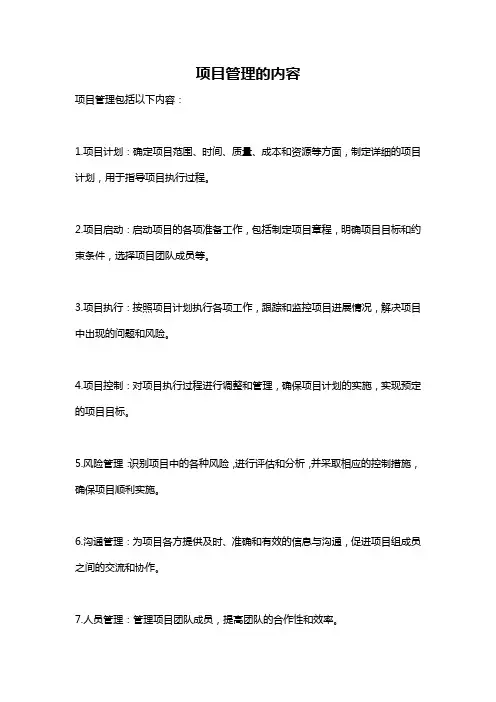
项目管理的内容
项目管理包括以下内容:
1.项目计划:确定项目范围、时间、质量、成本和资源等方面,制定详细的项目计划,用于指导项目执行过程。
2.项目启动:启动项目的各项准备工作,包括制定项目章程,明确项目目标和约束条件,选择项目团队成员等。
3.项目执行:按照项目计划执行各项工作,跟踪和监控项目进展情况,解决项目中出现的问题和风险。
4.项目控制:对项目执行过程进行调整和管理,确保项目计划的实施,实现预定的项目目标。
5.风险管理:识别项目中的各种风险,进行评估和分析,并采取相应的控制措施,确保项目顺利实施。
6.沟通管理:为项目各方提供及时、准确和有效的信息与沟通,促进项目组成员之间的交流和协作。
7.人员管理:管理项目团队成员,提高团队的合作性和效率。
8.质量管理:确保项目成果符合项目要求和用户需求,并且达到质量标准。
9.变更管理:识别并处理项目中出现的变更请求,进行变更分析和评估,并做出相应的决策。
10.项目关闭:项目完成后的总结和评估,制定项目完成报告,并善后处理项目的资源和财务问题等。

什么是项目管理项目管理是一种管理方法,它涉及在特定的时间范围内,按照预定的预算、资源和目标完成一个特定的任务。
它被用于规划和组织各种类型的项目,从建筑和制造到IT和市场营销等。
项目管理包括一系列工具和技术,以确保项目按时、按预算完成,同时保持高质量。
项目管理的目标是确保项目在规定时间内,符合质量要求和预算的基础上,得到成功的实施。
在项目管理中,团队负责制定计划并将其分解为可管理的任务,以确保项目按计划执行。
项目管理涉及到需要管理的团队、需求和变更管理、持续的风险管理、通信和完成足够的资源来完成项目。
项目管理是一个复杂的过程,涉及到许多不同领域的技能和专业知识。
包括规划、组织、执行、监控和收尾等五个阶段。
在规划阶段,项目经理评估项目的需要,确定可用资产,定义目标、作为一个成功项目的标准和其他有关问题。
规划的重点是制定项目计划和确保项目的目标与组织战略保持一致。
在组织阶段,项目经理要启动项目,并分配任务。
要协调团队中的不同成员,指导团队完成他们的任务并确保控制项目的质量。
项目经理要确保项目按计划执行,与项目利益相关者保持良好的沟通,并确保在规定时间内获得所需资源。
在执行阶段,项目经理要持续地监测项目的进展情况,确保项目按照计划逐步完成。
此阶段的重点是管理项目中的资源,确保项目满足利益相关者的要求。
在监控阶段,项目经理要对项目进行审查,以确保项目按时间、质量和成本的要求完成。
要监测项目的预算和时间线,并采取必要的措施进行修正和改进。
监控阶段的目的是确保项目在整个项目生命周期中得到全面的支持和管理。
在收尾阶段,项目经理要完成各项任务,评估整个项目的成功,以备案和总结经验。
还要对项目进行归档,记录所有相关信息,以备将来回顾、合规和重用。
项目管理是一种理解项目的尝试,对团队进行协调和管理,以最大程度地满足项目中使用的资源、质量和时间的要求。
项目管理可以使项目团队更好的规划、组织和控制,从而达到预期的目标。
项目管理的主要内容有哪些
项目管理主要包括以下内容:
1.项目范围管理:确定和确认项目包括哪些工作,不包括哪些工作。
2.项目时间管理:涉及项目时间规划,活动定义、活动排序、活动持续时间
估计、进度安排、进度控制等。
3.项目成本管理:确保项目在预算范围内完成所需的资源计划、成本估算、
预算编制和成本控制。
4.项目质量管理:保证项目满足预定的需求和需求的能力的各种管理过程。
5.项目人力资源管理:有效发挥参与项目人员作用的管理过程。
6.项目沟通管理:确保项目信息及时且恰当地收集、生成、发布、存储、检
索、处理和最终处置。
7.项目风险管理:涉及风险识别、风险评估、风险量化、风险应对措施的规
划与实施,以及对未预期到的风险的监控。
8.项目采购管理:对从项目组织外部获得所需产品或服务的管理过程。
9.项目干系人管理:确保满足干系人的需要和期望,以及对其管理和有效控
制的过程。
以上内容是项目管理知识体系中常见的九大领域,每个领域都有各自的知识点及相应的工具和技术。
项目管理方案(优秀8篇)项目管理工作计划篇一项目进度管理知识域包括使项目按时完成所必需的各个管理过程,进度管理的步骤为:活动定义,活动排序,活动资源估算,活动历时估算,制订进度计划,按进度执行项目,在制定进度计划和执行这个计划过程中,如果计划的执行出现偏离,或计划本身发生了变化,则启动进度控制过程或进度变更过程。
在本书中,进度管理也叫时间管理。
8.1 概念和交付物1. 概念1) 活动:WBS包含完成项目所需的所有工作,用于界定项目的范围。
WBS的最小工作单元是工作包。
如果工作包作为进度管理的基础,则显得太过粗糙,因此必须对工作包进行分解。
此处细分是将项目的组成部分细分为更小、更易于管理的单元,以便更好的进行进度管理和控制,此处分解的最终成果就是活动。
一个活动通常需要一定的时间、一定的成本和一定的资源才能完成,所有这些时间、成本和资源都要通过预算或估计才能得到近似的数量。
2)里程碑:里程碑是项目中的重大事件或重要时间点,通常指一个可交付成果的完成。
一个项目中应该有几个关键事件作为里程碑。
一个好的里程碑的最突出的特征是,对于达到这个里程碑的标准没有模糊性。
3)工期:完成一个项目所需的纯工作时间(不包括节假日或其他休息日)。
4)、工期:完成活动所需要的日历时间段(该时间段由起始日期、工作日、节假日或其他休息日,结束日期组成).5)强制依赖:指工作中固有的依赖关系,也称硬逻辑关系。
6)任意依赖关系:指项目组确定的那些依赖关系,也可以是软逻辑关系。
7)外部依赖:指那些受外部因素制约的依赖。
8)逻辑关系:两个项目活动或一个项目活动和一个里程碑之间的依赖关系,也称为前导关系或者依赖关系,四种可能的'逻辑关系为:① 完成-开始:后继活动的工作开始前,前导活动必须完成。
② 完成-完成:后继活动的工作完成前,前导活动的工作必须完成。
③ 开始-开始:后继活动的工作开始前,前导活动的工作必须开始。
④ 开始-完成:后继活动的工作完成前,前导活动的工作必须开始。
项目管理九大要素:范围、时间、成本、质量、人力、沟通、风险、采购、综合管理项目管理包括以下内容:1.项目范围管理:定义项目的范围,包括项目的目标、任务、成果和约束条件,以及项目的边界和限制。
2.项目时间管理:制定项目的时间表,包括项目的起始时间、结束时间、里程碑和关键路径,以及时间变更管理和进度计划变更管理。
3.项目成本管理:估算项目的成本,包括人力成本、物资成本、服务成本和餐饮成本等,以及成本控制和管理,确保项目不超出预算。
4.项目质量管理:制定项目的质量计划,包括项目的质量标准、质量控制措施、质量改进措施和质量管理文件等,以及项目的质量保证和管理。
5.项目人力资源管理:制定项目的人力资源计划,包括项目的人员需求、人员配备、人员培训和绩效评估等,以及项目的人员管理和协调。
6.项目沟通管理:制定项目的沟通计划,包括项目的信息发布、会议组织、报告编写和沟通渠道管理等,以及项目的沟通协调和信息交流。
7.项目风险管理:识别项目的风险,包括项目的风险评估、风险控制和风险应对措施等,以及项目的风险管理文件和风险监控。
8.项目采购管理:制定项目的采购计划,包括项目的采购方式、采购文件、供应商选择和合同管理等,以及项目的采购执行和采购评估。
9.项目综合管理:综合管理项目的范围、时间、成本、质量、人力资源、沟通、风险和采购等各个方面,确保项目的整体协调和顺利进行。
以上是项目管理的各个方面,它们相互关联、相互影响,是确保项目成功实施的重要保障。
在项目管理中,需要制定详细的项目管理计划,并不断监控、调整和优化项目管理计划的实施,确保项目能够按时、按质、按预算完成。
同时,需要与项目相关方进行有效的沟通和协调,解决项目中出现的问题和挑战,确保项目的顺利进行。
做好项目管理的10个方法项目管理是一个细致而复杂的过程,需要综合运用多种方法和技巧来确保项目的成功实施。
下面是做好项目管理的10个方法:1.制定清晰明确的项目目标:在项目启动阶段,确定所要实现的具体目标和成果是至关重要的。
项目目标需要明确、具体,并且可以量化,以便能够确切地衡量项目的成功。
2.制定详细的项目计划:在项目开始之前,制定一个详细的项目计划可以帮助项目团队理解项目的范围、时间表、资源需求等关键方面。
项目计划应该包括清晰的里程碑和任务列表,以便跟踪项目的进展。
3.分配合适的资源:为了使项目顺利进行,需要分配合适的人力、物力和财力资源。
资源分配应根据项目计划和需求进行,以确保每个任务都有足够的资源支持。
4.建立有效的沟通机制:项目管理是一个协作的过程,沟通对于项目团队的合作至关重要。
建立一个有效的沟通机制,确保项目团队成员之间以及与项目的相关方之间能够有效地交流信息和解决问题。
5.设定合理的时间表:制定一个合理的时间表可以帮助项目团队管理和控制项目进度。
时间表应该考虑到项目的复杂性、资源可用性以及相关方的期望,以便能够合理地安排任务和里程碑。
6.风险管理:项目管理过程中难免会有各种风险和挑战。
建立一个风险管理机制,可以帮助项目团队及时识别并应对潜在的问题和风险,减少项目失败的可能性。
7.定期评估和监控项目进展:定期评估和监控项目的进展是保证项目成功的关键环节。
通过定期的进展评估和监控,可以及时发现和纠正问题,确保项目按计划进行。
8.灵活应对变更:在项目执行过程中,可能会出现一些变更和调整的情况。
项目管理需要具备应对变更的机制和能力,能够根据实际情况进行调整和灵活应对。
9.关注团队合作和团队建设:项目成功离不开一个高效的团队。
项目管理应该关注团队合作和团队建设,培养团队成员之间的合作精神和协作能力。
10.后期总结和经验分享:项目结束后,进行项目总结和经验分享可以帮助团队总结经验教训,为将来的项目提供有价值的参考。
项目管理四大措施项目管理是指对项目进行计划、组织、控制和协调的一系列活动,以达到项目的目标。
为了有效地管理项目,需要采取一些措施来确保项目的顺利进行。
本文将介绍项目管理的四大措施,分别是项目计划、项目组织、项目控制和项目协调。
一、项目计划项目计划是项目管理的第一步,也是最重要的一步。
项目计划包括制定项目目标、确定项目范围、制定项目进度计划、资源分配等。
项目计划的目的是为了明确项目的目标和任务,规划项目的时间和资源,为项目的实施提供指导。
在制定项目计划时,需要考虑项目的可行性、风险和约束因素。
可行性分析可以评估项目是否可行,风险评估可以预测项目可能面临的风险,约束因素可以限制项目的范围和资源。
通过综合考虑这些因素,可以制定出合理可行的项目计划。
二、项目组织项目组织是指为项目组织成员分配任务和责任,建立项目团队,确保项目的顺利实施。
项目组织的关键是明确各个成员的角色和责任,并建立有效的沟通渠道。
在项目组织中,需要确定项目经理和项目团队成员。
项目经理负责项目的整体管理和决策,项目团队成员负责具体的任务执行。
通过明确各个成员的角色和责任,可以提高项目的组织效率和协作能力。
三、项目控制项目控制是指对项目的执行过程进行监督和控制,确保项目按照计划进行,达到预期的目标。
项目控制包括收集和分析项目数据,监测项目进度和成本,及时发现和解决项目中的问题。
在项目控制中,需要制定项目的监控指标和控制措施。
监控指标可以用来衡量项目的进展和效果,控制措施可以用来修正项目中的偏差和问题。
通过有效的项目控制,可以确保项目按照计划进行,及时解决问题,提高项目的成功率。
四、项目协调项目协调是指在项目执行过程中,协调各个相关方的利益和需求,解决项目中的冲突和矛盾,确保项目的顺利进行。
项目协调需要建立良好的沟通和协作机制,解决各方的分歧和问题。
在项目协调中,需要建立项目管理委员会和项目沟通渠道。
项目管理委员会负责协调各方的利益和需求,项目沟通渠道可以用来传递信息和解决问题。
什么是项目管理
项目管理是一种将计划、组织、指导、监控和控制资源以实现预期的目标的方法论。
它涉及从项目的开始到结束的整个生命周期,并确保在时间、成本和质量方面的交付成功。
项目管理是一种跨职能领域,涉及多个学科如工程、商务、信息技术等,因此要求项目经理具有广泛的技能和专业知识。
项目管理的目标是实现项目目标从而增加商业价值,这一价值可以通过提高工作效率、减少成本、优化资源利用和提升客户满意度等方式实现。
在项目的成本、时间、范围和质量等方面的要求常常是冲突的,有时候只能取其中之一或几个来进行优化,因此项目管理需要项目经理具备做出权衡和决定的能力以使整个项目运行顺利。
对于每一个项目,项目经理需要确定项目的目标和要求、制定项目计划、组织资源、执行和控制进度、质量和成本,并确保项目被按时交付、在预算范围内,并能实现客户的期望。
此外,他们也需要与客户和团队成员进行良好的沟通,以及处理可能出现的风险和问题。
项目管理是一种成熟、系统、规范的管理方法,通常包括以下方面的内容:
1. 项目启动和计划:这包括制定项目范围和目标、确定项目可行性、确定项目需求、制定项目计划并确定资源需求、和制定项目团队组建等;
2. 项目执行:这包括组织和分配团队成员和资源、监督项目进度、质量和成本等方面的情况,并与客户沟通进行项目
调整;
3. 项目控制:这包括检查和审查项目进度、成本和质量的情况,查找和处理风险以及问题,确保项目下一步进展的顺利;
4. 项目收尾:这包括验证并交付项目成果、维护项目文档、项目总结和反馈等。
总之,项目管理需要专业知识、专业技能、交际和领导能力,以确保项目的可交付性及其价值。
这促成了项目管理成为一个不断成长和臻于完美的领域。
Why are people spending more work time on projects?With increased international competition, customers are demanding to have their products and services developed and delivered better, faster, and cheaper. Since project management techniques are designed to manage such factors as scope, quality, cost and schedule, they are ideally suited to this purpose.There are though a number of tradeoffs which may need to be made when managing a project. These include time but may also involve tradeoffs being made among the scope (size), quality (acceptability of the results), cost, and schedule.What does bottom-up estimating involve?Bottom-up estimating is a method of estimating a component of work. The work is decomposed into more detail. An estimate is prepared of what is needed to meet the requirements of each of lower, more detailed pieces of work, and these estimates are then aggregated into a total quantity for the project. For a bottom-up estimate, the WBS needs to be broken down to the most detailed level and the specifications need to be very clear. In the elevator example, bottom-up estimates were created in Kansas City. Details to be estimated included exactly how many buttons the control panel had; exactly what kind of high fixtures were mounted in the ceiling, what kind of finish was requested, and so on. The cost was estimated for each item. For example, for the process of installing the guide rail, first there was a small amount of time, such as one hour, to set up or get everything in place to do this step. Then, it took a certain fraction of an hour of labor to secure each foot of the rail into position. A material charge was incurred for the guide rails themselves and the fasteners that held them in place. The cost of supervision was charged for the foreperson that ensured work was scheduled and performed properly. Finally, over costs were allocated to each of fixed costs.Bottom-up estimating is the most detailed, time-consuming, and potentially accurate way to estimate. Most projects use this method eventually to serve as a basis for estimating cash flow needs and for controlling the project. One important caution on bottom-up estimating is to ensure that every item is included. If a portion of the project is left out, that portion is underestimated by 100 percent.Why is a risk register so important in project?Risk register is the primary output of risk identification. It is a living document with much information regarding risks. A risk register should be maintained, detailing all identified risks, responsibilities, actions required and decisions made. Keep the risk register updated with any results from risk response planning. The purpose of a risk register is to record details of all risks that have been identified, together with their analysis and plans for how those risks are to be treated. The risk register is an important component of the overall risk management framework. It will include ALL risks - not just operational risks, and can be focused either on the enterprise as a whole, or on specific projects where it is used to maintain the register of project risks over the lifetime of the project.What does the process of outsourcing involve?Many times if all of the necessary resources cannot be found within the organization, additional resources are hired from outside. The entire project can be outsourced or some activities on it can be outsourced. Outsourcing isn’t a simple way to have a project done. The resource needs, schedule, clear expectations regarding time frames and deliverables must be communicated if outsourcing is to succeed.Step 1: The measure of outsourcing your company whether it is meaningful. In analyzing the need for your stage of outsourcing, the company's existing business to do a benchmark survey to determine the extent to which they comply with industry standards.Step 2: Make sure the partners. When you start your operations or a specific part of the project outsourcing, you must be straightforward and honest with your team and discussion. You should also consider the introduction of a third-party outsourcing specialist to help you do choose to carry out negotiations.Step 3: contract negotiations. Keep in mind three key elements of the contract negotiations: the outset of the contract termination of a good planning; outsourcing partners must also be profitable; negotiations based on cost, the final decision, focus on quality and people. Needless to say, this stage is the drafting of all parties to abide by the unbreakable service agreement.Step 4: maintain cooperative relations soundly. To make each of the participants are happy to accept outsourcing projects or services and frank, considering the introduction of an independent company to carry out quality assessment. Also, do not forget even if you are outsourcing, you're still its owner. As CIO, you must always process supervision, project sequencing and overall direction to take full responsibility.The strategic planning processIn the course of normal business activity, a company’s leadership p erforms strategic planning to set direction in line with the organization’s vision, mission, goals and objectives. This strategic planning process generally features:Strategic analysis–analyze strengths and weaknesses within the organization and opportunities and threats external to the organization. Guiding principles–create statements of organizational vision,mission, purpose and/or values to guide decision-making. Strategic objectives– often annual are planning to establish short and long term results that will support guiding principles. Flow-down objectives –optional for large or complex organizations to ensure that appropriate goals are established. Portfolio alignment– selecting a set of projects to support organizations’ goals.When defining scope, why is it important to clarify objectives? Scope Planning is a statement encompassing the project justification, the deliverables, and the objectives. The primary purpose of project scope management is to ensure that all the required work and only the required work is performed to complete the project successfully. This is accomplished by defining and controlling what is included in the project and what is not. Scope planning is the process of creating a project scope management plan. Scope planning = product scope + project scopeScope definition is an important part of project planning because all other planning is based upon the project scope. While the requirements collected represent the customers’ statement of what they need, the defined scope is the project team’s response—asking the customer, ―if we provide this, will it solve your problem?‖ it is impossible to estimate how much a will cost, how many workers will be needed, how long a project will take, what risks are involved, or what quality standards will be involved without first understanding what the project includes.Scope definition also is vital in preventing scope creep. Scope creep happens for two common reasons. First, if the scopes not clearly defined and agree upon, it is easy to add to the project work without realizing that more time and money will be required. Second, sometimes when a project is going well, a customer is so excited that he or she asks an innocent-sounding question:can the project output also do…..? The pe rson performing the project work is often flattered and agrees with understanding the implications. In contemporary business, pleasing the customer is desirable. However, the best time to gain customer understanding is when the project team id defining the scope—not while working to implement it.Why is knowledge management important?If a company does extensive project work and uses project management capability as an organizational strength, it is important to keep developing expertise in it. One way to develop and expand expertise is to capture and reuse the knowledge developed. Knowledge is ―a conclusion drawn from information after it is linked to other information and compared to what is already known.‖ In order to increase knowledge and successfu l use and reapplication of it, organizations often create a lessons learned knowledge base.For this database to be useful, it is important to communicate project successes and failures from all aspects of the project process. Captured throughout the life of the project, recommendations to improve future performance can be based on technical, managerial, and process aspects of the project. In addition, part of the project closeout process should include facilitating a lessons earned session for the entire project, especially on unsuccessful projects.The process of project management also consists of a number of various and related knowledge and skills areas. Scope management–determining all the work that is necessary for project completion; Time management–defining, sequencing, and estimating duration, and resourcing work activities as well as developing and controlling the schedule; Cost management –planning, estimating, budgeting, and controlling costs; Quality management–involving quality planning, assurance, and control; Human Resource management –acquiring, developing, and managing the project team; Communications management – generating, collecting, disseminating, storing, and disposing of timely and appropriate project information; Risk management – risk identification, analysis, response planning, and monitoring and control; Procurement management–purchasing or acquiring product and services as well as contract management; Integration management–unifying and coordinating the other knowledge areas by creating and using tools such as charters, project plans, and change control.Project roles: Project executive, managerial and associate rolesThere are three project executive level roles: the steering team, the chief projects officer, and the project sponsor.The four project managerial level roles are the project manager, functional manager, facilitator, and senior customer representative.The project manager: is directly accountable for the project results, schedule, and budget; is the main communicator; and often must get things done through the power of influence since his or her formal power may be limited. The functional managers are section, division or department heads that determine how the work of the project gets accomplished; often supervise that work and often negotiate with the project manager regarding which workers are assigned to the project. A facilitator is sometimes assigned to complex or controversial projects to assist the project manager with the process of running meetings and making decisions. The senior customer representative ensures that the needs and wants of the various constituents in the customer’s organization are identified and prioritized and that project progress and decisions continually support the cust omer’s desires. Senior Customer Representative represents the project customer – to whom the outcomes of the project are handed over to at completion of the project.The two associate level project roles are core team members and subject matter experts. Core team members are assigned to the project for its entire duration if possible and jointly make decisions with the project manager. Subject matter experts are brought in as needed to help with specific project activities.Again, it is important to understand though that there is a difference between the two roles.Core team members are ideally assigned to the project for its entire duration. They work with the project manager to make decisions, perform hands-on work, and sometimes supervise the work of subject matter experts. However, subject matter experts are brought onto the project when needed to perform specific activities. They are not normally involved in making project-wide decisions or in supervising the work of others.A significant challenge for global managers in the management of projects both domestically and worldwide is that it requires that they possess both ‘soft’ and ‘hard’ skills.These soft skills may include communication and leadership – often seeking to understand various stakeholders’ needs and persuading people to do work. In addition, projects are often conducted within an interdisciplinary situation in which no one person knows everything and the project manager often lacks or does not have the formal authority or power within the company to order people to perform.In terms of hard skills needed in managing projects, these skills can include risk analysis, quality control, scheduling, and budgeting work. Most projects have many ‘unknowns’ risks. Projects are subject to quality expectations –often formal standards, but at least expectations. And, of course, it goes without saying that projects almost always have limits of time and money!The project life cycleProject life cycles provide a guiding point for determining the scope and resource requirements of specific projects. By outlining a project’s life cycle, many challenges and potential pitfalls can be pinpointed. More generally, an understanding of project life cycles lends itself to a better understanding of how projects function within an organization and how they differ from conventional forms of corporate process.There have been identified a number of features/issues that pertain to each stage of the project life cycle. These are as follows: Initiating– when a project is proposed, planned at a high level, and key participants commit to it in broad terms; Planning–starts after the initial commitment, includes detailed planning, and ends when all stakeholders accept the entire detailed plan; Executing–includes authorizing, executing, monitoring, and controlling work until the customer accepts the project deliverables; and Closing – all activities after customer acceptance to ensure project is completed, lessons are learned, resources are reassigned, and contributions are recognized.What is a project? How are projects different from ongoing operations?A project is an endeavor that requires an organized set of work efforts that are planned in a level of detail that is progressively elaborated as more information is discovered. Projects are subject to limitations of time and resources such as money and people.The enterprise internal research work can be divided into two parts: one is the daily operation, is a project. The daily operation and project the main difference between: daily operation is continuous and repetitive, and the project is one-time and unique. The basic characteristics of project performance in: 1, it has a clear goal. Each project is a particular project products, is for a clear goals and set up. 2, it is by a series of interrelated tasks to form. 3, the entire project has a finite resource. For example, time and manpower cost, etc. 4, project is a one-off and uniqueness of activities. It has clear start and end time with makeshift.。